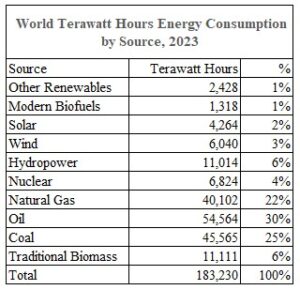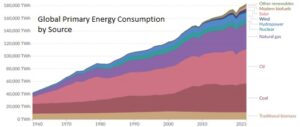Renewable Energy Sources
Two articles appearing a few days apart in June 2024 suggest that bountiful, cheap, clean energy is on a path to achievability by mid-21st century. The June 22, 2024, edition of The Economist featured a cover story titled “Dawn of the Solar Age.” The Washington Post published an article days later titled “The Stage Is Being Set for an American Nuclear Power Revolution.” Each article foresees rapid growth in capacity for the respective sources of clean energy.
The growth in solar energy capacity is truly exponential. Capacity doubles roughly every three years. At that rate, capacity increases  tenfold every decade. As a share of total energy consumption in 2023, solar energy accounted for two percent, according to the charity Our World in Data. Other sources place that share as high as six percent. The table from Our World in Data reports world consumption in Terawatt Hours. In our homes we are familiar with paying for our own utilization of electricity in Kilowatt Hours. A watt is a measure of electrical power. A watt-hour is a measure of electrical energy supplied by one watt in one hour.
tenfold every decade. As a share of total energy consumption in 2023, solar energy accounted for two percent, according to the charity Our World in Data. Other sources place that share as high as six percent. The table from Our World in Data reports world consumption in Terawatt Hours. In our homes we are familiar with paying for our own utilization of electricity in Kilowatt Hours. A watt is a measure of electrical power. A watt-hour is a measure of electrical energy supplied by one watt in one hour.
- A Kilowatt = 1,000 Watts (One thousand)
- A Megawatt = 1,000,000 Watts (One million)
- A Gigawatt = 1,000,000,000 Watts (One billion)
- A Terawatt = 1,000,000,000,000 Watts (One trillion)
A one Megawatt power plant produces 1,000 kilowatts of power as long as it’s operating at full capacity. It produces 1,000 kilowatt-hours of power each hour it operates, or 24,000 kilowatt-hours per day, and 8,670,000 kilowatt-hours per 365-day year.
 The 2023 graph of energy consumption by source highlights both the minor role currently filled by solar energy, and the distance solar must go to fulfill its potential. A ten-fold increase per decade will require a number of decades before replacing current levels of fossil fuels. Solar energy will also be called upon to satisfy rapidly growing demand. As The Economist article states, in Africa alone there are 600 million people who currently have no electricity at all. Electricity is projected to be cheap enough that those people will be able to go from having no electricity to enjoying air conditioned buildings. (Click on graph to enlarge.)
The 2023 graph of energy consumption by source highlights both the minor role currently filled by solar energy, and the distance solar must go to fulfill its potential. A ten-fold increase per decade will require a number of decades before replacing current levels of fossil fuels. Solar energy will also be called upon to satisfy rapidly growing demand. As The Economist article states, in Africa alone there are 600 million people who currently have no electricity at all. Electricity is projected to be cheap enough that those people will be able to go from having no electricity to enjoying air conditioned buildings. (Click on graph to enlarge.)
Wind energy currently supplies slightly more electricity than solar. It is transitioning to ever larger turbines, longer blades, and new configurations. The growth in this source is projected to make wind energy nearly as plentiful as solar.
Production of nuclear energy is shrinking in the United States. Retired nuclear plants have not been replaced. On July 9, 2024, President Biden signed the Fire Grants and Safety Act after it was approved by the Senate on an 88 to 2 vote. The Act will reduce the time required to get nuclear permitting through the regulatory process and incentivize research into advanced nuclear reactor technologies. Former coal-fired power plants will be retrofitted for nuclear power production.
Georgia Power’s nuclear power Plant Vogtle in Waynesboro, Georgia was completed with its fourth reactor operational in April 2024. There are 94 nuclear reactors operating in 54 nuclear power plants in the United States, and none currently under construction. Of the 59 nuclear reactors under construction world-wide, 25 are in China. The Fire Grants and Safety Act is designed to reverse the trend.
Future energy for airplanes, ships, trucks, and cars requires new solutions that do not include the excessive, extra weight of batteries. Hydrogen offers a solution. Using renewable electricity, hydrogen plants extract hydrogen from water to produce what has been named green hydrogen. Billions of dollars are being invested to develop hydrogen as a fuel for transportation, without generating more pollution in this energy-intensive process.
Benefits of these technologies in terms of reduced carbon emissions will emerge slowly over the next two decades. Exponential growth of renewable energy promises gradual relief from global warming in the second half of this century.
